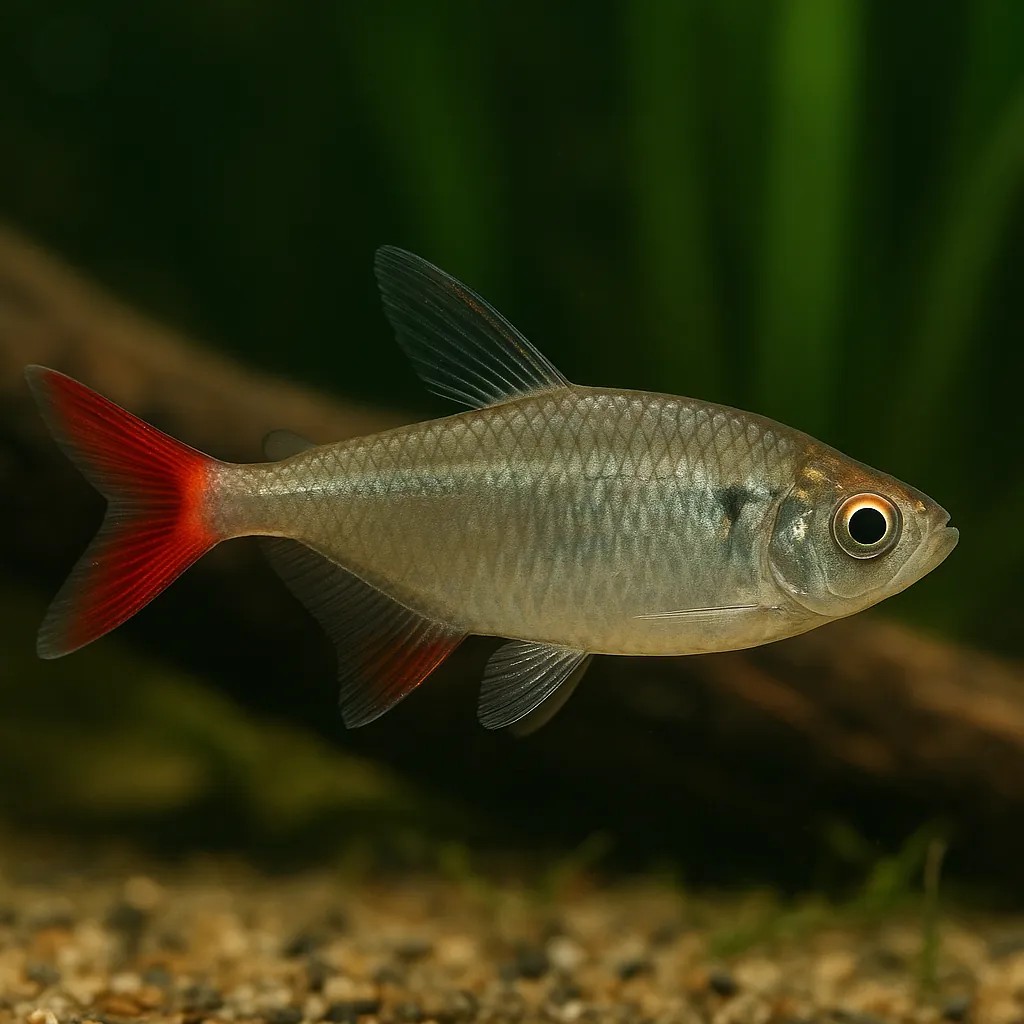
Bloodfin tetra
Introduction
The Bloodfin Tetra (Aphyocharax anisitsi) is a popular freshwater fish among aquarists, renowned for its striking silver body and vibrant red fins. This hardy species is well-suited for both beginner and intermediate fishkeepers due to its adaptability and peaceful nature. Bloodfin Tetras are active swimmers and thrive in community tanks, making them an excellent choice for those looking to add dynamic movement and color to their aquariums.
Care and Environment
Providing optimal care for Bloodfin Tetras involves attention to tank size, water parameters, filtration, lighting, feeding, and tank decor.
What is the minimum tank size for Bloodfin Tetras?
A minimum tank size of 40 liters (10 gallons) is recommended to accommodate a small school of Bloodfin Tetras. However, a larger tank of at least 75 liters (20 gallons) is ideal for a more substantial group, allowing ample swimming space and reducing stress among the fish.
What are the ideal water parameters for Bloodfin Tetras?
Bloodfin Tetras thrive in water temperatures between 21°C and 27°C (70°F to 80°F), with a pH range of 6.0 to 8.0. They prefer soft to moderately hard water, with a general hardness (GH) between 3 and 12 dGH. Consistent water quality is crucial, so regular monitoring and maintenance are essential.
How should the tank be set up for Bloodfin Tetras?
Incorporate a dark substrate, such as gravel or river sand, to mimic their natural environment and enhance their coloration. Adding live plants like Java Moss or floating species provides hiding spots and reduces stress. Ensure the tank has moderate lighting and a gentle to moderate water flow, replicating their native river habitats. A reliable filtration system is necessary to maintain water quality, and regular partial water changes (25-50% bi-weekly) are recommended to keep the environment clean.
What should I feed my Bloodfin Tetras?
Bloodfin Tetras are omnivorous and accept a variety of foods. A balanced diet includes high-quality flake or pellet food supplemented with live or frozen options like brine shrimp, bloodworms, and daphnia. Offering small portions two to three times daily ensures they receive adequate nutrition without overfeeding.
Origin and Habitat
Bloodfin Tetras are native to the Paraná River basin in South America, specifically in Argentina and Paraguay. They inhabit clear, fast-moving streams and rivers with abundant vegetation and moderate water flow. These environments provide ample hiding spots and a diverse diet, contributing to their adaptability in various aquarium settings.
Temperament and Compatibility
Bloodfin Tetras are peaceful, schooling fish that thrive in groups of at least six. Keeping them in a school reduces stress and encourages natural behaviors. They are generally compatible with other small, non-aggressive species.
Which tank mates are suitable for Bloodfin Tetras?
Suitable tank mates include other small tetras, danios, rasboras, corydoras catfish, and peaceful invertebrates like shrimp and snails. These companions share similar water parameter requirements and temperaments, creating a harmonious community tank.
Are there any fish that should be avoided as tank mates?
It's advisable to avoid housing Bloodfin Tetras with larger, aggressive species or fish with long, flowing fins, such as angelfish and guppies. Bloodfin Tetras have been known to nip at the fins of such fish, leading to potential stress and injury.
Interesting Facts
Bloodfin Tetras are known for their longevity, often living up to 5 to 8 years in well-maintained aquariums. They are also recognized for their hardiness, making them an excellent choice for novice aquarists. During breeding, females can lay between 300 to 500 eggs, which they scatter among plants. To prevent the adults from consuming the eggs, it's recommended to remove them from the breeding tank post-spawning.
Sources
All information in this article has been gathered from the following reputable sources:
Overview
Recommended Tank Size 19.8 Gallons (for groups of 6 or more) |
Minimum Group Size 6 |
Minimum Tank Volume 10.6 Gallons |
Maximum Adult Length 2.2 inches |
Average Adult Length 2 inches |
Shoaling (6+ required) Yes |
Preferred Water Type Freshwater, soft to moderately hard, neutral to slightly acidic |
Temperature Range (°C) 21–27 |
pH Range 6.0–8.0 |
Water Hardness (dGH) 3–12 |
Typical Lifespan (years) 5 years |